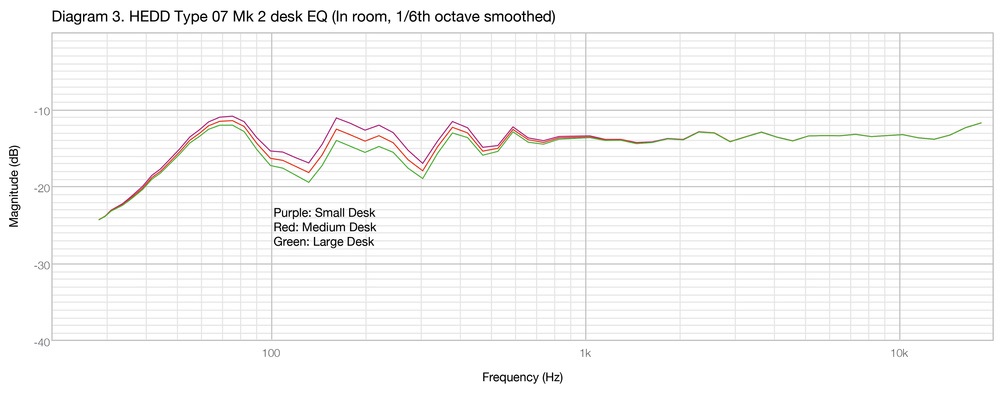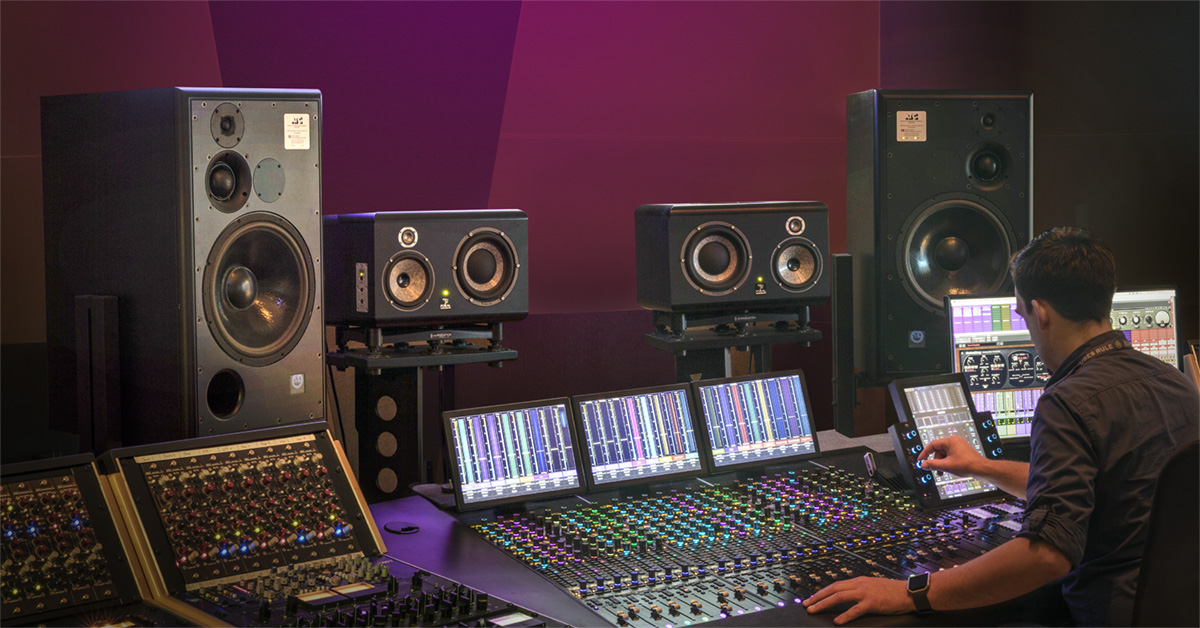Frequency Response in Studio Monitors
Introduction
Did you know that the human ear can hear frequencies ranging from 20Hz to 20kHz? In this article, I will delve into the importance of frequency response, how it is measured, and what constitutes a good response.
We’ll also explore the difference between flat and shaped response, and how to interpret frequency response graphs and specifications. Get ready to elevate your studio setup!
What is frequency response?
When it comes to studio monitors, understanding the concept of frequency response is crucial. Frequency response refers to the range of frequencies that a device, such as headphones or speakers, can reproduce accurately.
It’s usually measured in hertz (Hz) or kilohertz (kHz) and is represented graphically in a frequency response curve. This spec gives you a detailed insight into how well a studio monitor can handle different frequencies across the audible spectrum.
A flat frequency response is desirable, as it means that the monitor reproduces all frequencies equally without any bias or distortion. By analyzing the frequency response, you can ensure that your studio monitors accurately reproduce the audio you’re working on, allowing for precise and innovative sound production.

Why frequency response is important?
Understanding the overall frequency response is important because it provides a comprehensive evaluation of how accurately a studio monitor can reproduce different frequencies. This spec is crucial for audio equipment enthusiasts, producers, and engineers who desire innovation and value high-quality sound reproduction. Here’s why frequency response is important:
- Contextually relevant: Frequency response allows us to assess how well a studio monitor can reproduce the entire audible frequency range, ensuring that every detail in the audio signal is faithfully represented.
- Sound quality: A flat frequency response ensures that the studio monitor doesn’t introduce any unwanted coloration or distortion to the audio, resulting in a more accurate and enjoyable listening experience.
- Variations in frequency response: By understanding the variations in frequency response, we can identify any potential shortcomings or peaks in certain frequency ranges, helping us make informed decisions when choosing studio monitors for specific applications.
What frequency range do I need for studio monitors?
To determine the ideal frequency range for studio monitors, I need to consider the specific needs and preferences of my audio production workflow. The frequency range refers to the range of frequencies that a studio monitor can reproduce accurately.
It’s crucial to choose a frequency range that aligns with the type of audio content I work with. For example, if I primarily produce music with deep bass elements, I’d benefit from a studio monitor with a lower frequency range. On the other hand, if I focus on dialogue editing or voice-over work, a wider frequency range with a more balanced response across the spectrum would be more suitable.
Understanding the frequency response specification, as indicated in the frequency response chart and measurements, is essential for interpreting the monitor’s ability to reproduce sound accurately.
How Frequency Response is Measured?
Since frequency response is an important specification in studio monitors, it’s necessary to understand how it’s measured.
Frequency response is typically measured using a microphone and a test signal generator. The test signal generator produces a range of frequencies, from low to high, which are then played through the studio monitor.
The microphone captures the sound output from the studio monitor and records the amplitude of each frequency. These amplitude measurements are then plotted on a graph, with frequency on the x-axis and amplitude on the y-axis, to create the frequency response curve.
The curve shows how the studio monitor responds to different frequencies, indicating its ability to accurately reproduce low and high frequencies. The frequency response is usually represented in hertz (Hz) and decibels (dB), providing a detailed understanding of the studio monitor’s acoustic performance across the entire frequency range.

What is a Good Frequency Response?
In my opinion, a good frequency response for studio monitors will provide a balanced and accurate reproduction of sound across the entire frequency spectrum. A flat response is desirable, meaning that the studio monitors accurately reproduce all frequencies at the same volume level.
The frequency response is typically represented graphically, with frequency on the x-axis and volume level on the y-axis. A good frequency response should cover the entire range of human hearing, which is approximately 20 Hz to 20 kHz. It should also accurately reproduce the range of audio that’s present in the content being played.
Interpreting frequency response can be complex, but a good frequency response ensures that the listener can hear all the details and nuances of the sound being played, resulting in a more immersive and accurate listening experience.
Flat vs. Shaped Frequency Response
When comparing the frequency response of studio monitors, two main types can be distinguished: flat frequency response and curved frequency response.
A flat frequency response means that the monitor reproduces sound accurately across the entire audible frequency range, with minimal variations.
On the other hand, a curved frequency response implies that certain frequencies are boosted or attenuated to shape the sound according to specific preferences or room acoustics.
Understanding the differences between these two types of frequency response is crucial in selecting the most suitable studio monitors for precise audio reproduction.
Flat Frequency Response
I prefer a flat frequency response in my studio monitors because it provides a more accurate representation of the audio being played. A flat frequency response means that the studio monitors reproduce the audio signal without any added emphasis or attenuation on specific frequencies.
Here are two reasons why a flat frequency response is important:
- Accurate representation: A flat frequency response ensures that what you hear through your studio monitors is a faithful reproduction of the actual sound. This is crucial for professionals in the pro audio industry who need to make critical decisions based on what they hear.
- Consistency across systems: Having a flat frequency response in your studio monitors allows for consistency when working with different headphones and speakers. It helps in translating the mix to other playback systems accurately, ensuring that your audio sounds good across various platforms.
Curved Frequency Response
Ideally, I always prefer a flat frequency response in my studio monitors to ensure accurate audio reproduction. However, it’s important to understand that not all studio monitors exhibit a perfectly flat frequency response.
Some monitors are designed with a shaped frequency response, which means that certain frequencies are boosted or attenuated to achieve a specific sound signature. This can be useful in certain situations, such as when mixing or mastering music where you want to emphasize certain frequencies. Shaped frequency response can also be advantageous in near-field monitors, where the bass response may need to be enhanced due to their smaller size.
However, it’s important to consider the phase response as well, as altering the frequency response can affect the overall coherence and accuracy of the audio.
Frequency Response Graphs & Specifications
I will now discuss the points of frequency response graphs and specifications.
Frequency response graphs provide a visual representation of how a studio monitor responds to different frequencies. By comparing frequency response graphs, we can analyze the differences in performance between different studio monitors and make informed decisions based on our specific requirements.
Frequency Response Graphs
The frequency response graphs provide a visual representation of how a studio monitor performs across different frequencies. By measuring the frequency response, we can understand the speaker’s ability to accurately reproduce sound across the entire audible spectrum.
When specifying frequency response, it’s important to consider the input signal used for testing. Different input signals, such as pink noise or sine waves, can produce varying responses in speakers.
When we look at the frequency response graph, we can identify peaks and dips in the speaker’s output at specific frequencies. Ideally, a perfectly flat frequency response would indicate that the speaker reproduces sound accurately at all frequencies. However, in reality, the response might deviate from a flat line due to various factors such as room acoustics or design choices.
Understanding the frequency response graph allows us to make informed decisions about the performance of studio monitors.
Comparing Frequency Response Graphs
When comparing frequency response graphs, it’s important to analyze the differences and similarities between the speaker’s performance across various frequencies. The frequency response graph provides us with valuable information about how a pair of studio monitors or speakers reproduces sound across the entire range of audio frequencies.
The graph typically plots the speaker’s response in decibels (dB) against the frequency in Hertz (Hz). By examining the graph, we can identify the speaker’s fundamental frequency range, which is the range where the speaker performs best.
It’s crucial to know how to interpret the frequency response graph, especially in audiophile and consumer audio circles. This knowledge helps us choose the right headphones or speakers that will accurately reproduce the audio frequencies we desire.
What is the difference between Frequency Range and Frequency Response?
Typically, frequency range refers to the span of frequencies that a device can reproduce, while frequency response describes how accurately the device reproduces those frequencies. Understanding the difference between these two terms is crucial in evaluating the performance of studio monitors or any audio equipment.
Here’s a breakdown of the distinctions:
Frequency Range:
- Defines the lowest and highest frequencies that a device can produce or reproduce.
- Measured in Hertz (Hz) or Kilohertz (kHz).
- Determines the capability of the device to handle different audio signals.
- Important for instruments that produce sound in specific frequency ranges.
Frequency Response:
- Describes how accurately a device reproduces frequencies across its range.
- Indicates the device’s ability to reproduce audio signals without distortion or alteration.
- Usually depicted on a graph showing the device’s sensitivity to different frequencies.
- Takes into account the human ear’s sensitivity to different frequencies and the concept of octaves.
Frequently Asked Questions
What is the difference between Frequency Range and Frequency Response?
Frequency range refers to the span of frequencies that a device can reproduce, whereas frequency response describes how accurately the device reproduces those frequencies. The frequency range is measured in Hertz (Hz) or Kilohertz (kHz) and determines the capability of the device to handle different audio signals. On the other hand, frequency response indicates the device’s ability to reproduce audio signals without distortion or alteration, usually depicted on a graph showing the device’s sensitivity to different frequencies. While frequency range focuses on the breadth of frequencies a device can handle, frequency response evaluates the device’s accuracy in reproducing those frequencies.
What frequency range do I need for studio monitors?
The ideal frequency range for studio monitors depends on the specific requirements of your audio production workflow and the type of content you work with. It’s crucial to choose a frequency range that aligns with your preferences and needs. For instance, if you work primarily with music containing deep bass elements, you would benefit from studio monitors with a lower frequency range. Conversely, if your focus is on dialogue editing or voice-over work, a wider frequency range with a more balanced response across the spectrum would be more suitable. Understanding the frequency response specification, as indicated in the frequency response chart and measurements, is essential for interpreting the monitor’s ability to reproduce sound accurately.
How Frequency Response is Measured?
Frequency response is typically measured using a microphone and a test signal generator. The test signal generator produces a range of frequencies, from low to high, which are then played through the studio monitor. The microphone captures the sound output from the studio monitor and records the amplitude of each frequency. These amplitude measurements are then plotted on a graph, with frequency on the x-axis and amplitude on the y-axis, to create the frequency response curve. This curve illustrates how the studio monitor responds to different frequencies, indicating its ability to accurately reproduce low and high frequencies. The frequency response is usually represented in hertz (Hz) and decibels (dB), providing a detailed understanding of the studio monitor’s acoustic performance across the entire frequency range.
Conclusion
So I believe that now you know everything that you need to know about frequency response and range and that you know when some peaks or dips will appear on the chart, no matter if they are in the low frequencies or in the upper ones.
My advice will be to look deeper into these specifications in your reference monitors before making the purchase and analyze the actual frequency response of a speaker. So if you have any troubles, feel free to reach out and I will try to answer everybody! Until next time.
- Best Mixing Subwoofers: Top 10 Sub Monitors To Improve Your Mix!
- Best Midfield Studio Monitors: Top 8 Models You Can Go For!
- Best 8 Inch Studio Monitors: Top 11 Picks + Reviews!
- Best Adam Audio Monitors: Top 8 Choices + Reviews!
- Best KRK Studio Monitors: Our Honest Review on 8 Models!
- Best Passive Studio Monitors: Top 5 Models + Brief Reviews!





